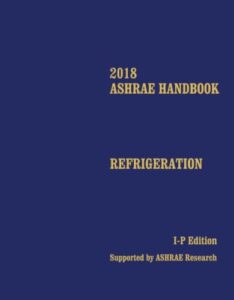ASHRAE Handbook Refrigeration IP and SI 2018
ASHRAE Handbook Refrigeration IP and SI 2018
ASHRAE Handbook Refrigeration IP and SI 2018 covers the refrigeration equipment and systems for applications other than human comfort. This volume includes data and guidance on cooling, freezing, and storing food; industrial and medical applications of refrigeration; and low-temperature refrigeration.
ASHRAE Handbook Refrigeration IP and SI 2018 is the process of moving heat from one loca- tion to another

by use of refrigerant in a closed cycle. Oil management; gas and liquid separation; subcooling, superheating, desuperheating, and piping of refrigerant liquid, gas, and two-phase flow are all part of refrigeration. Applications include air conditioning, commercial refrigeration, and industrial refrigeration. This chapter focuses on systems that use halocarbons (halogenated hydrocarbons) as refrigerants. The most commonly used halogen refrigerants are chlorine (Cl) and fluorine (F).
ASHRAE Handbook Refrigeration IP 2018 CONTENTS
- Contributors
- ASHRAE Technical Committees, Task Groups, and Technical Resource Groups
- ASHRAE Research: Improving the Quality of Life
- Preface
- SYSTEMS AND PRACTICES
- COMPONENTS AND EQUIPMENT
- FOOD COOLING AND STORAGE
- REFRIGERATED TRANSPORT
- FOOD, BEVERAGE, AND FLORAL APPLICATIONS
- INDUSTRIAL APPLICATIONS
![ASHRAE Handbook Refrigeration IP and SI 2018]()
- LOW-TEMPERATURE APPLICATIONS
- GENERAL
- ADDITIONS AND CORRECTIONS
- INDEX
Halocarbon refrigerants are classified into four groups: chlorofluorocarbons (CFCs), which contain carbon, chlorine, and fluorine; hydrochlorofluorocarbons (HCFCs), which consist of carbon, hydrogen, chlorine, and fluorine; hydrofluorocarbons (HFCs), which contain carbon,
hydrogen, and fluorine; and hydrofluoroolefins (HFOs), which are HFC refrigerants derived from an alkene (olefin; i.e., an unsaturated compound having at least one carbon-to-carbon double bond). Examples of these refrigerants can be found in Chapter 29 of the 2017 ASHRAE Handbook—Fundamentals. Desired characteristics of a halocarbon refrigeration system may
include
- Year-round operation, regardless of outdoor ambient conditions
- Possible wide load variations (0 to 100% capacity) during short periods without serious disruption of the required temperature levels
- Frost control for continuous-performance applications
- Oil management for different refrigerants under varying load and temperature conditions
- System efficiency, maintainability, and operating simplicity
- Operating pressures and pressure ratios that might require multistaging, cascading, etc.
Download
ASHRAE Handbook Refrigeration IP 2018
ASHRAE Handbook Refrigeration SI 2018
OR


Comments are closed.